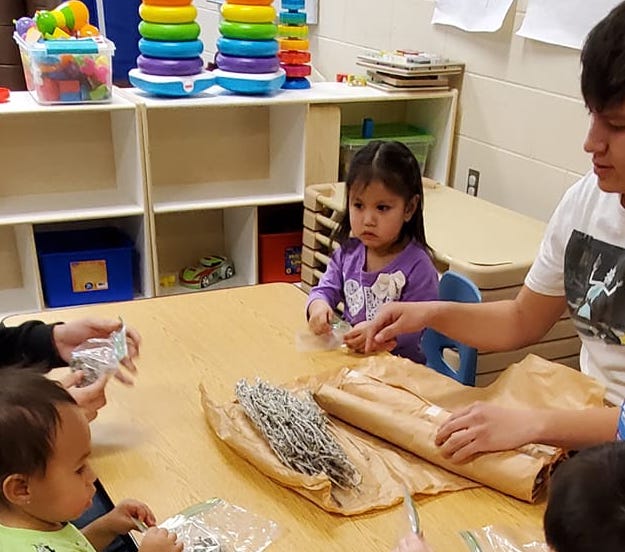While waiting lists for child care are common in cities like Sioux Falls and Rapid City, it can be impossible to find any child care options in rural and reservation communities in South Dakota.
According to a recent report by South Dakota Kids Count, a non-profit data center, seven counties in South Dakota have no state-registered daycare programs. A News Watch analysis of state data shows that in an 11-county area in north-central South Dakota, a 19,000-square-mile region from north of Pierre west to the Montana border with about 32,000 people, there are only 16 registered child-care programs, most of them small in-home centers with 12 or fewer spots for children.
Finding open daycare slots for children on the Pine Ridge Indian Reservation has always been a challenge, with waiting lists for open slots a common occurrence.
But obtaining child care has been even more difficult during the pandemic, according to Stacey Marrufo, a supervisor at the Kyle Learning Center in Kyle, S.D.
Depending on the level of community spread of COVID-19, the federally funded community center may have to close or severely restrict child admissions, Marrufo said.
Even before the pandemic, parents had to scramble to find open daycare slots so they could keep working, she said. When spots are limited due to COVID-19, many parents have to call on relatives or stay home from work to care for children.
“There’s just not enough day care and programs here to cover our working parents and custodial parents,” Marrufo said. “It’s essentially for workers, and a real need, but there’s so many parents that need accommodations and we’re really limited here.”
The child-care crisis has worsened on South Dakota reservations due to the temporary closures of federal Head Start programs, which provide subsidized care for children from birth to 5 in low-income families, according to Pigeon Big Crow, director of the Oglala Sioux Tribe child-care program.
With Head Start centers shut down, and no privately operated day care available on the reservation, working parents are forced to seek spots for their children in the tribal child- care system, which could not meet the need for child care on the reservation before the COVID-19 pandemic, Big Crow said.

The pandemic has cut child-care capacity at the six federally funded OST tribal child-care centers to zero at times, and to about half in mid-December, she said. The tribe has supplemented its day-care centers by providing federal funding as well as training and regulation to more than 100 in-home providers on the reservation, she said.
But the in-home system has faltered during the pandemic, as home providers suspended or ceased operations due to fears of spreading COVID-19 among adults and children. With closures of Head Start and restricted enrollments at OST daycare centers, the situation has reached crisis mode on the reservation, Big Crow said.
In-home providers who undergo training and regulation are paid a fee for their services but do not receive insurance or other benefits, making the job less attractive to many reservation residents, she said.
Some reservation parents have to drive their children great distances to receive safe child care, then drive to work and then back to pick up children before driving home, sometimes adding up to a two-hour daily round trip, Big Crow said.

The tribe’s strict rules regarding COVID-19, put in place to protect vulnerable residents from the coronavirus, have added to challenges for working parents, Big Crow said. OST centers and in-home providers must turn away any child showing symptoms of illness, she said.
“If your kid wakes up with a runny nose, you are going to have to stay home and care for them, so there’s a lot of last-minute scrambling by parents to make it work,” Big Crow said.
Some parents decide it is not worth the cost or trouble to get day care and quit working as a result, further exacerbating economic problems in reservation families and communities, Big Crow said.
“Day care is expensive, and it’s a lot of work to get, and being able to trust that your child is cared for while you’re at work, it’s just not worth the trouble for some people to continue working,” she said.
Some working families also make too much money to qualify for subsidized child care, which also can create a disincentive to staying in the workforce, Big Crow said. With no private child care and no openings in the tribal system, those parents have to find in-home providers on their own, which can be difficult or result in placing children in unregulated daycare situations.
Some relief may come in spring 2022 when a new OST child-care center will open in Pine Ridge, creating slots for up to 60 infants and toddlers, and after-school slots for up to 100 children.
Non-reservation rural areas and small towns are also enduring major challenges in access to day care.
Rachel Talich runs an at-home day care in Murdo and is believed to be the only child-care provider in Jones County, S.D.
Talich, 40, was a social worker but decided to open a day care when she and her husband had a second child about two years ago.

With a full roster of 12 children at any one time, and charging about $25 a day per child, Talich said she earns a similar wage to what she made as a social worker. “I’m always full here,” she said.
But Talich noted that other in-home providers in the Murdo area have recently closed because they were concerned about COVID-19, found the work too consuming or did not make enough money to justify the stress.
“It’s a difficult field to be in; it’s a lot of stress,” she said. “You’re dealing with up to 12 different personalities a day, you have crying babies, and some are harder to soothe than others so it can get difficult.”
Talich said she mostly enjoys the time with the children and gets joy from watching them play, grow and develop.
She also realizes the importance of her role in the small ranching and tourism town in central South Dakota.
“I know I’m the only day care in the county, so unfortunately, if we have COVID, or any illness, and I do have to close, you can tell it puts a big strain on families,” she said. “A lot of them, when I close, they rotate with friends or families, and some parents just have to take a few days off from work.”
Talich said she would support any program that provided funding for parents or providers to bring the cost of day care down for families. She also hopes that daycare workers will get more respect for the important work they perform, which could encourage more young people to enter the field.
“It’s important that it is looked at as a needed and important profession,” Talich said. “They might think, ‘Oh, she’s just a daycare provider, but I have a bachelor’s degree in education, and this is the choice I’m making to be able to stay home and raise my daughter.”
Allyssa Kinsley is one of Talich’s clients, and drops off her daughter, Allie, for day care typically three days a week.
Kinsley is an emergency-room nurse at Avera St. Mary’s Hospital in Pierre, where she commutes an hour each way for three 12-hour shifts per week.
In less than three years since her birth, Allie has had six different daycare providers, Kinsley said. Each time, Kinsley had to scramble to find a new provider when in-home child-care providers in the area closed for one reason or another.
“We’ve had a rough go with daycare providers in our town,” said Kinsley, who moved from Iowa to Murdo in 2015 when her husband, who grew up in Murdo, got a job as a bank loan officer in town. “It’s been very challenging, but I’ve been fortunate that with each closure, I’ve been able to find someone new.”
Kinsley said her struggle to maintain good-quality child care is similar to what her colleagues in Pierre undergo even though the city is much larger. Some co-workers who are also mothers have to use all their paid time off to take care of children during holidays or illnesses rather than use time away for a vacation, Kinsley said.
“It’s very all-consuming,” she said. “It puts a real stress on you.”
Kinsley said that unless new child-care options are created in Murdo or other small towns, populations in rural South Dakota communities may continue to fall and economies may continue to struggle.
“It’s making it harder for young families to come back, because there’s no one to take care of their kids,” she said. “If you had a good job in a small town, what do you do? You’d have to take a different job or stay home.”
One business in Murdo, the Rusty Spur Steakhouse, is adapting to the daycare shortage by allowing employees to bring their children to work so the parents can stay on the job and the restaurant can remain open.
Deanna Dunker is a mother of two who is a server at the restaurant, and she brings her children to the steakhouse after they are done at school so she can complete her shifts, which usually end at 4 or 5 p.m. The children, ages 4 and 5, stay safely in the upstairs portion of the restaurant while Dunker works.
“We have them upstairs so they’re not in the way, so it works out pretty well.” Dunker said. “It’s just kind of a way of making it work.”
Dunker said she might not be able to work if her employer did not offer the after-school option. “It’s hard to get day care here and I really can’t afford it,” she said. “I would probably be a stay-at-home mom otherwise.”




